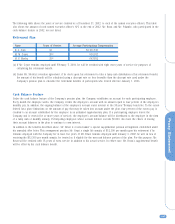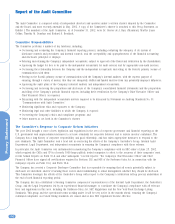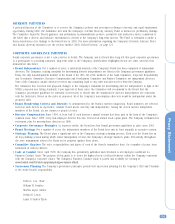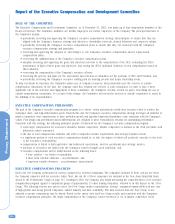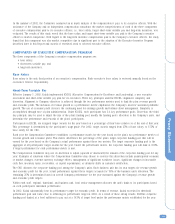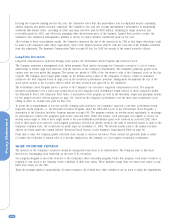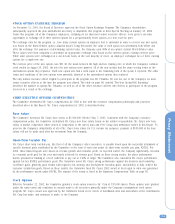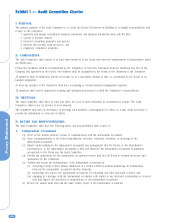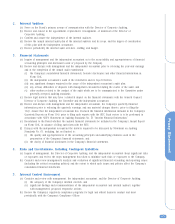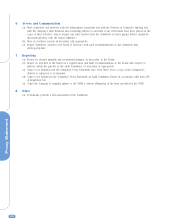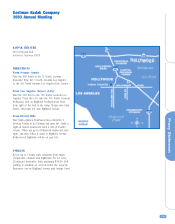Kodak 2002 Annual Report Download - page 118
Download and view the complete annual report
Please find page 118 of the 2002 Kodak annual report below. You can navigate through the pages in the report by either clicking on the pages listed below, or by using the keyword search tool below to find specific information within the annual report.
Proxy Statement
113
STOCK OPTION EXCHANGE PROGRAM
On November 12, 2001, the Board of Directors approved the Stock Option Exchange Program. The Company’s shareholders
subsequently approved the plan amendments necessary to implement this program at their Special Meeting on January 25, 2002.
Under this program, all of the Company’s employees, excluding its six then most senior executive officers, were given a one-time
opportunity to exchange all of their current options for a proportionately fewer options at a new exercise price.
The exchange ratio for the program, i.e., how many current options an employee had to surrender in order to receive one new option,
was based on the Black-Scholes option valuation model. Using this model, the value of each option was determined both before and
after the exchange. For purposes of determining current value, the Company used 90% of an option’s current Black-Scholes value.
These values were then compared to determine an appropriate exchange ratio based on the current option’s existing exercise price.
While some options were exchanged on a one-for-one basis, in the vast majority of cases, an employee exchanged two or three existing
options for a single new one.
The exercise price of the new options was $31.30, the mean between the high and low trading price at which the Company’s common
stock traded on August 26, 2002, the date the new options were granted. All of the new options had the same vesting terms as the
surrendered options they replaced. Each new option also had a term equal to the remaining term of the option it replaced. The other
terms and conditions of the new options were generally identical to the surrendered options they replaced.
The only named executive officer eligible to participate in the program was Mr. Palumbo. He was not one of the Company’s six most
senior executive officers at the time the program was offered. The table on page 99, entitled “Ten-Year Option/SAR Repricing,”
describes the number of options Mr. Palumbo, as well as all of the other executive officers who elected to participate in the program,
received as a result of the exchange.
CHIEF EXECUTIVE OFFICER COMPENSATION
The Committee determined Mr. Carp’s compensation for 2002 in line with the executive compensation philosophy and practices
described above in this Report. Mr. Carp’s compensation for 2002 is described below:
Base Salary
The Committee increased Mr. Carp’s base salary to $1,100,000 effective May 5, 2003. Consistent with the Company’s executive
compensation policy, the Committee established Mr. Carp’s new base salary based on his relative responsibility. Mr. Carp’s new base
salary is market competitive when viewed in comparison to the survey data and Peer Group data mentioned earlier in this Report. To
preserve the Company’s deductibility of all of Mr. Carp’s base salary for U.S. income tax purposes, payment of $100,000 of his base
salary will not be made until after his retirement from the Company.
Short-Term Variable Pay
Mr. Carp’s short term variable pay, like that of all the Company’s other executives, is payable based upon the successful attainment of
specific financial goals established by the Committee at the start of each year under its short-term variable pay plan, EXCEL. For
2002, these financial goals were based on revenue growth and economic profit. As reported earlier, the Company significantly exceeded
its economic profit goal for the year and nearly achieved its revenue goal. Based on these strong results, the plan’s performance
matrix provided for funding at a level sufficient to pay out at 143% of target. The Committee also considered Mr. Carp’s performance
against his key EXCEL performance goals. The Committee noted Mr. Carp’s strong performance against his diversity and leadership
excellence goals, generally good results with regard to his strategy and development execution goals, and inability to fully achieve his
customer satisfaction goals. Based on these results, the Committee fixed Mr. Carp’s 2002 award at level equal to what was generated
by the performance matrix under EXCEL. The amount of the award is listed in the Summary Compensation Table on page 96.
Stock Options
Effective November 22, 2002, the Committee granted a stock option award to Mr. Carp of 175,000 shares. These options were granted
under the same terms and conditions as awards made to all executives generally under the Company’s management stock option
program. Mr. Carp’s award was approved by the Committee based on its review of benchmark data and assessment of the contributions
Mr. Carp has made, and continues to make, to the Company.




